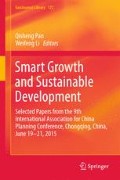Abstract
Historical urban forms which have experienced long evolution, are resilient and durable. It is important for urban planning to explore the everlasting wisdom and principle from them. Taking Chengdu as an example, this paper collects satellite data, historical literature and maps, integrates history investigation, geographic information and morphologic analysis to identify the historical urban forms from the existing city, and studies their composition and characteristics. It suggests that the characteristics of urban form result from the local environment, functions of city, and historical cultures and customs; that the respectful and matter-of-fact attitude to nature, the local experience and wisdom developed by people to adapt or make good use of environments is crucial; and that historical urban forms are valuable and influential to the present urban form.
Access this chapter
Tax calculation will be finalised at checkout
Purchases are for personal use only
Notes
- 1.
The shape and location of urban forms are not accurate, but their relative positions to the topography are correct.
- 2.
Before the Qin Dynasty, there were frequent floods in the Min River and droughts in the Chengdu pain. Libing built Dujiangyan to solve this problem. They divided the Ming River into an outer river and an inner river. Though making good use of the topography, they conducted the floods to the outer river, the necessary water to the inner river. After that, the flood can be controlled well and enough water can be obtained to irrigation.
References
Bosselmann P.: Urban transformation: understanding city design and form. Washington: Island Press (2008)
Cai Zongxin.: The evolution of water system on Chengdu and its role in city development [J]. Journal of Southwest China Normal University, (04) pp. 573–578 (1990)
Conzen M. R. G.: Alnwick, Northumberland: a study in town-plan analysis. London. Institute of British Geographers (1969)
Kai G.: Urban morphology: an introduction and evaluation of the theories and the methods. Urban Planning, 25(12), pp. 36–41 (2001)
Lynch K.: The image of the city. The MIT Press (1960)
Morris A. E. J.: History of urban form: before the industrial revolutions. London: Pearson education limited (1994)
Mumford L.: The city in history: Its origins, its transformations, and its prospects. New York: Harcourt, Brace and word, Inc (1961)
Rossi A.: The architecture of the city. The MIT Press (1982)
Serge Salat.: Cities and forms: on sustainable urbanism. Lu Yang, Zhang Yan, translate. Beijing: China Architecture and Building Press (2012)
Sichuan Research Institute of Culture and History.: The history of Chengdu. Chengdu: Chengdu Times Press (2006)
Spiro Kostof.: The city shaped: Urban patterns and meanings through history. Thames & Hudson (1999)
Wu Qingzhou. Chengdu: A Successful Example of Urban Flood Control in Ancient Chinese Cities [J]. South Architecture (6) pp. 9–13 (2008)
Xia Chun, Liu Haowu, review of Funan River in Chengdu: people.settlements.environments.cities [J]. City Planning Review, (11) pp. 69–71 (2001)
Ying Jinhua, Fan Bingeng. Sichuan historical and cultural cities [M]. Chengdu: Sichuan People’s Press, (2000)
Zhao dianzeng, Li Mingbin.: The Ba-Shu culture in the upper reaches of the Yangtze River. Wuhan: Hubei Education Press (2004)
Acknowledgments
This study was supported by the Natural Science Foundation of China (51208530); the Fundamental Research Funds for the Central Universities (CDJZR12190008; 106112013CDJZR190001).
Author information
Authors and Affiliations
Corresponding author
Editor information
Editors and Affiliations
Rights and permissions
Copyright information
© 2017 Springer International Publishing AG
About this chapter
Cite this chapter
Li, X., Xu, L., Hanmei, Z. (2017). Distinguishing Characteristics of Urban Form from Evolutionary Perspective—The Case of Chengdu in China. In: Pan, Q., Li, W. (eds) Smart Growth and Sustainable Development. GeoJournal Library, vol 122. Springer, Cham. https://doi.org/10.1007/978-3-319-48296-5_1
Download citation
DOI: https://doi.org/10.1007/978-3-319-48296-5_1
Published:
Publisher Name: Springer, Cham
Print ISBN: 978-3-319-48295-8
Online ISBN: 978-3-319-48296-5
eBook Packages: Social SciencesSocial Sciences (R0)

